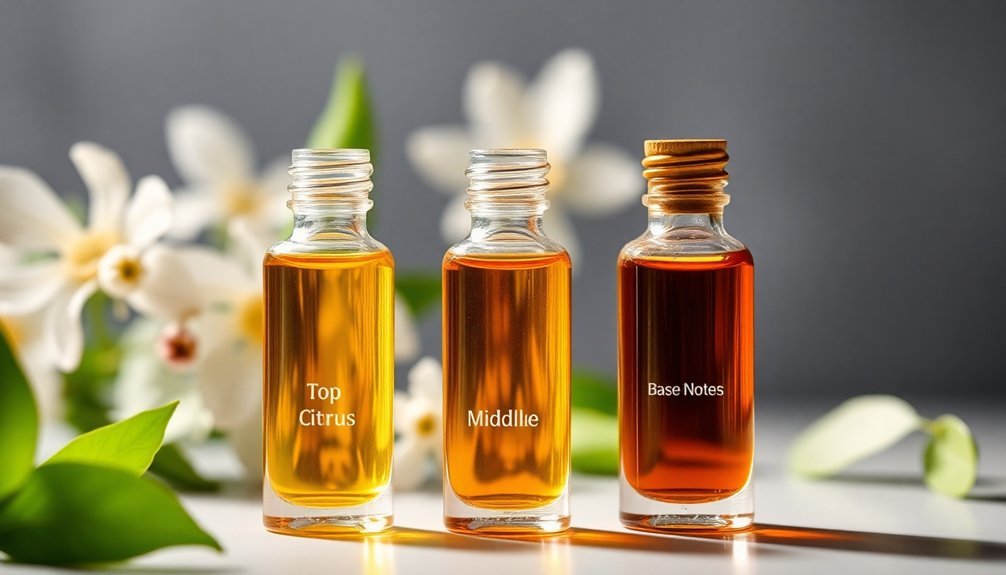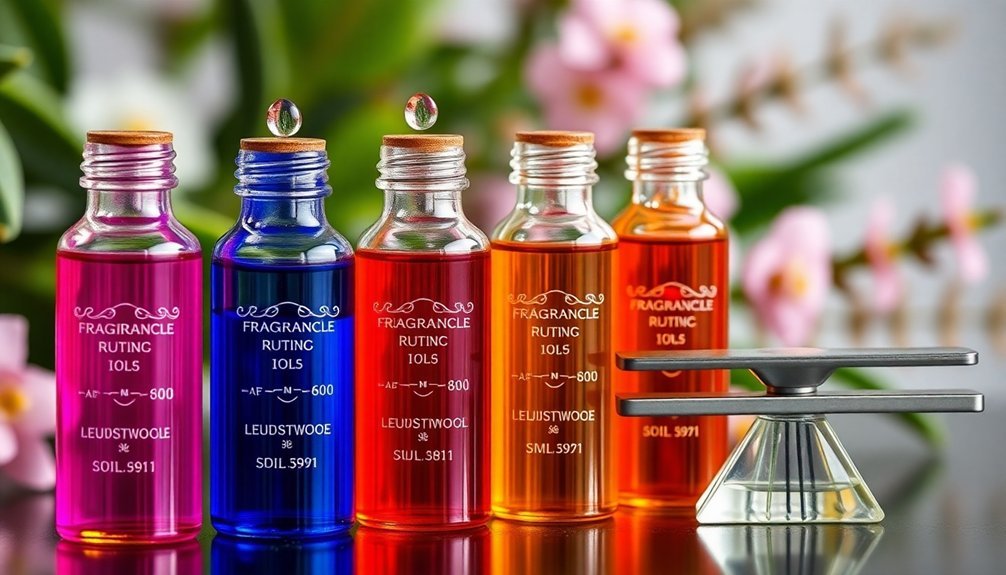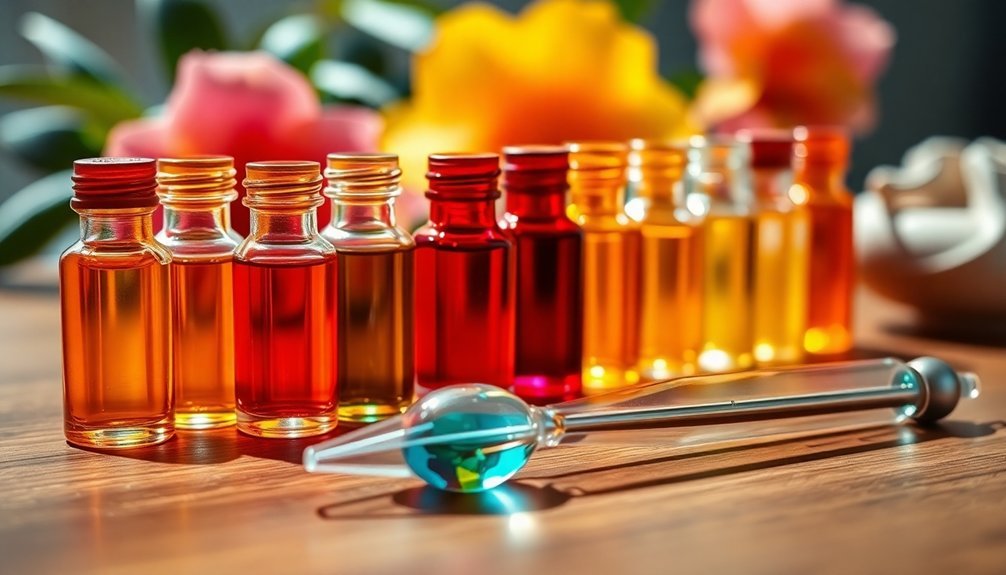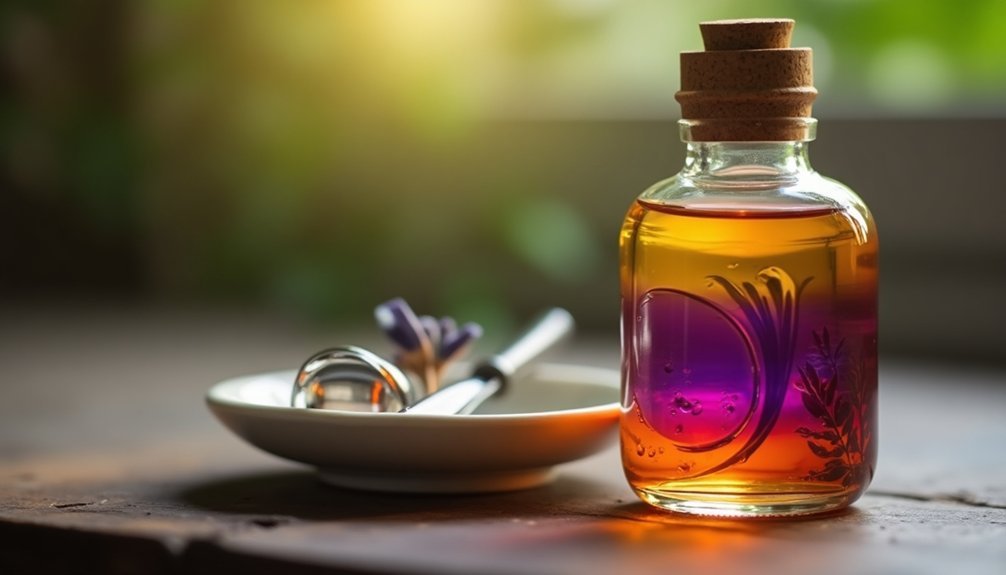For ideal perfume formulation, you'll want to follow these key dilution ratios: pure parfum at 20-30%, eau de parfum at 15-20%, eau de toilette at 5-15%, and eau de cologne at 2-5% fragrance oil concentration. When blending, stick to 30% top notes, 50% middle notes, and 20% base notes. For seasonal adjustments, use 15-20% oil concentration in winter and 5-10% in summer. The secrets of professional perfumery lie in mastering these essential proportions.
Essential Oil to Carrier Oil Ratios for Personal Perfumes

The art of creating personal perfumes requires careful attention to essential oil dilution ratios. You'll want to follow standard guidelines of 15-30 drops of essential oil per ounce of carrier oil, which typically translates to a 1-5% concentration.
For a 1% dilution, use 9 drops per ounce of carrier oil. Double that to 18 drops for a 2% solution, or use 43 drops for a 5% blend. You can adjust these ratios based on your desired fragrance intensity and the specific oils you're using.
Remember, using undiluted essential oils isn't safe for skin application. Start with your base notes first when adding oils to create a strong foundation for your perfume.
When selecting your carrier oil, consider jojoba, sweet almond, or fractionated coconut oil. These carriers not only dilute your essential oils safely but also enhance fragrance longevity and provide additional skin benefits.
Synthetic Fragrance Oil Blending Percentages
When working with synthetic fragrance oils, you'll need to adjust your concentration ratios based on whether you want a strong winter scent (15-20%) or a lighter summer blend (5-10%).
You can create stronger fragrances for cold weather by increasing the oil-to-solvent ratio, as lower temperatures tend to mute scent projection. Always conduct a patch test first before applying any new fragrance blend to ensure skin compatibility.
For warmer seasons, it's best to reduce your fragrance oil percentages to prevent the scent from becoming overwhelming in the heat.
Strong Vs Light Blends
Understanding fragrance oil concentrations helps you create either powerful or subtle scents in your perfume products.
For strong blends, you'll want to use a higher fragrance load of 15-18%, while light blends typically range from 5-10% of your total product weight.
When crafting strong blends, you can combine multiple synthetic fragrance oils since they're stable at higher concentrations. The ideal approach is to limit yourself to 2 to 4 oils in your blend for optimal results. However, you'll need to guarantee all oils are compatible to maintain product quality.
For lighter blends, consider using fewer oils to achieve an elegant, subtle effect that won't overwhelm the senses.
In both cases, you'll benefit from allowing your blends to mature over time.
Don't forget to test your combinations and follow IFRA safety guidelines, regardless of whether you're creating strong or light scents.
Seasonal Dilution Adjustments
Seasonal changes greatly influence how you'll adjust fragrance oil concentrations in your perfume formulations.
During warmer months, you'll want to create lighter, fresher scents using lower concentrations of 8-10%, while autumn and winter blends can handle slightly higher concentrations of 10-12% for richer, warmer fragrances.
For ideal seasonal perfume blending, follow these key adjustments:
- Use fixatives like vanilla or amber to stabilize your seasonal fragrances and prevent premature fading.
- Adjust your top, middle, and base notes proportionally to maintain harmony within each seasonal blend.
- Test your formulation in the intended wearing conditions – what works in winter might feel overwhelming in summer.
Remember to maintain proper safety dilutions regardless of season, never exceeding 5% for topical applications.
Top, Middle, and Base Note Proportions

The art of perfume creation relies on carefully balanced proportions of fragrance notes that work together harmoniously.
You'll want to start with top notes, which make up 20-40% of your blend and create the initial impression, using citrus oils and light florals that last 5-15 minutes.
Middle notes form the heart of your perfume at 50-75% of the composition, featuring warm florals and herbs like lavender and rose that persist for 20-60 minutes. They're essential for a smooth shift between layers.
For your foundation, use 5-10% base notes like vetiver or sandalwood, which provide lasting power for six hours or more.
While a basic ratio of 30% top, 50% middle, and 20% base notes works well, you can adjust these proportions to achieve your desired scent profile.
Eau De Parfum Vs Eau De Toilette Concentrations
When selecting between Eau de Parfum and Eau de Toilette, you'll notice significant differences in their concentration strengths, with EDP containing 15-20% fragrance oils compared to EDT's 5-15%.
You'll find that EDPs pack more intensity and staying power, typically lasting 4-5 hours, while EDTs offer a lighter, fresher scent that lasts 2-3 hours.
Your choice between the two will largely depend on the occasion, as EDPs work better for evening events while EDTs suit everyday wear.
Concentration Strength Comparison
Understanding fragrance concentrations helps you make informed decisions when selecting perfumes. When comparing Eau de Parfum (EDP) and Eau de Toilette (EDT), you'll notice significant differences in strength and longevity. EDP contains 15-20% fragrance oils, while EDT has 5-15%, resulting in distinct wearing experiences.
- EDP lasts 5-6 hours with potent projection, making it ideal for all-day wear, while EDT provides 3-5 hours of lighter scent coverage.
- You'll find EDP has a richer, more balanced fragrance due to its higher oil-to-alcohol ratio, whereas EDT emphasizes top notes.
- Your skin type matters – EDP's higher oil content often works better with natural skin oils, though both concentrations can suit sensitive skin.
The concentration you choose should align with your desired scent intensity and wearing duration.
Scent Longevity Differences
Scent longevity stands as a primary distinction between Eau de Parfum and Eau de Toilette concentrations.
You'll find that EDPs last markedly longer, typically 6-8 hours, while EDTs remain noticeable for just 3-5 hours. Your skin type plays an essential role in how long these fragrances persist – oily skin tends to hold scents longer than dry skin.
You'll notice that weather conditions affect both concentrations differently. In hot, humid weather, you'll need to reapply more frequently, while cooler temperatures help preserve the scent.
The fragrance notes also impact longevity – vanilla and musk notes in EDPs tend to linger longer than the lighter, citrus notes common in EDTs.
For ideal longevity with either concentration, you should apply the fragrance to moisturized skin and pulse points.
Safe Dilution Guidelines for Sensitive Skin

Since sensitive skin requires extra care and attention, following proper dilution guidelines is essential for creating safe, wearable perfumes.
You'll want to stick to a gentle 0.5-1% dilution ratio, using just 3-6 drops of essential oils per 30ml of carrier oil. Choose skin-friendly carriers like jojoba, sweet almond, or fractionated coconut oil to enhance your fragrance's safety profile.
Here are three vital safety steps to follow:
- Always perform a 24-48 hour patch test before applying your perfume blend.
- Start with ultra-low concentrations (0.2-0.5%) if you're new to fragrance oils.
- Never apply undiluted essential oils directly to your skin.
For facial applications, keep your dilution at 0.5-1.2%, and remember that elderly individuals or those with compromised skin shouldn't exceed 1% concentration.
Perfume Oil Strength Calculations for Different Seasons
Seasonal adjustments play an essential role in perfume oil concentrations, as temperature greatly impacts how fragrances perform on your skin.
During summer, you'll want to lower your fragrance oil concentration since heat amplifies scents. Aim for 5-15% concentration (EDT level) with citrus or floral bases to avoid overwhelming notes.
For winter, increase your concentration to 15-30% (EDP or Esprit de Parfum level) to combat the cold's dulling effect. Choose woody, spicy, or oriental bases for better projection.
Spring and autumn call for moderate concentrations of 10-20% (EDP level), adjusting slightly based on temperature fluctuations.
Remember to factor in your skin's natural heat when calculating ratios – warmer skin requires less concentration, while cooler skin needs more fragrance oil for peak performance.
Master Perfume Formulation Ratios

Precision defines the art of perfume formulation, where specific ratios determine the final product's strength and character.
You'll find that perfume concentrations range from pure parfum at 20-30% fragrance oils to the lighter eau de cologne at 2-5%. Understanding these ratios is essential for creating balanced fragrances that perform as intended.
- For traditional parfum, you'll want to use 20ml of fragrance oils per 100ml total volume, mixing your base, heart, and head notes in a 2:1:1 ratio.
- When crafting EDP, aim for 15-20% concentration, which works well for daily wear and offers moderate longevity.
- For lighter formulations, EDT uses 5-15% oils, while EDC requires just 2-5% for a revitalizing splash.
Remember to use precise measurements rather than drops, and always verify your calculations against safety guidelines.
Frequently Asked Questions
How Long Does Properly Diluted Perfume Last Before the Scent Starts Degrading?
You'll find that properly stored perfume can last 3-5 years before noticeable degradation. Keep it in a cool, dark place away from light and temperature changes to maintain its scent quality longer.
Can I Mix Different Carrier Oils Together for a Custom Perfume Base?
Yes, you can mix different carrier oils to create a custom perfume base. It's a great way to combine their unique benefits and properties while enhancing absorption, stability, and skin compatibility in your final fragrance.
What's the Best Water-To-Alcohol Ratio for Making Perfume Spray Versions?
You'll want to use 90-95% alcohol with 5-10% water content. If you're using 190 proof alcohol, you're already at the ideal ratio of 95% alcohol to 5% water.
Should Perfume Dilution Ratios Change Based on Humidity Levels?
You don't need to change perfume dilution ratios based on humidity. While humidity affects how you perceive fragrances, the core formulation should stay consistent. Instead, adjust your application amount for different conditions.
How Do Essential Oil Dilution Ratios Differ Between Children and Adults?
You'll need much lower dilutions for children than adults. Use 0.1-0.2% for infants, 0.25-1% for toddlers, 1-3% for older children, and 2-4% for teenagers and adults to guarantee safety.
In Summary
Now you're equipped with the essential ratios and calculations to create your own signature scents. Remember to start with lower concentrations and adjust based on your preferences and skin sensitivity. Whether you're crafting a light summer spritz or a rich winter blend, you'll find success by following these proven dilution guidelines. Don't forget to document your formulations—your perfect fragrance awaits.





Leave a Reply